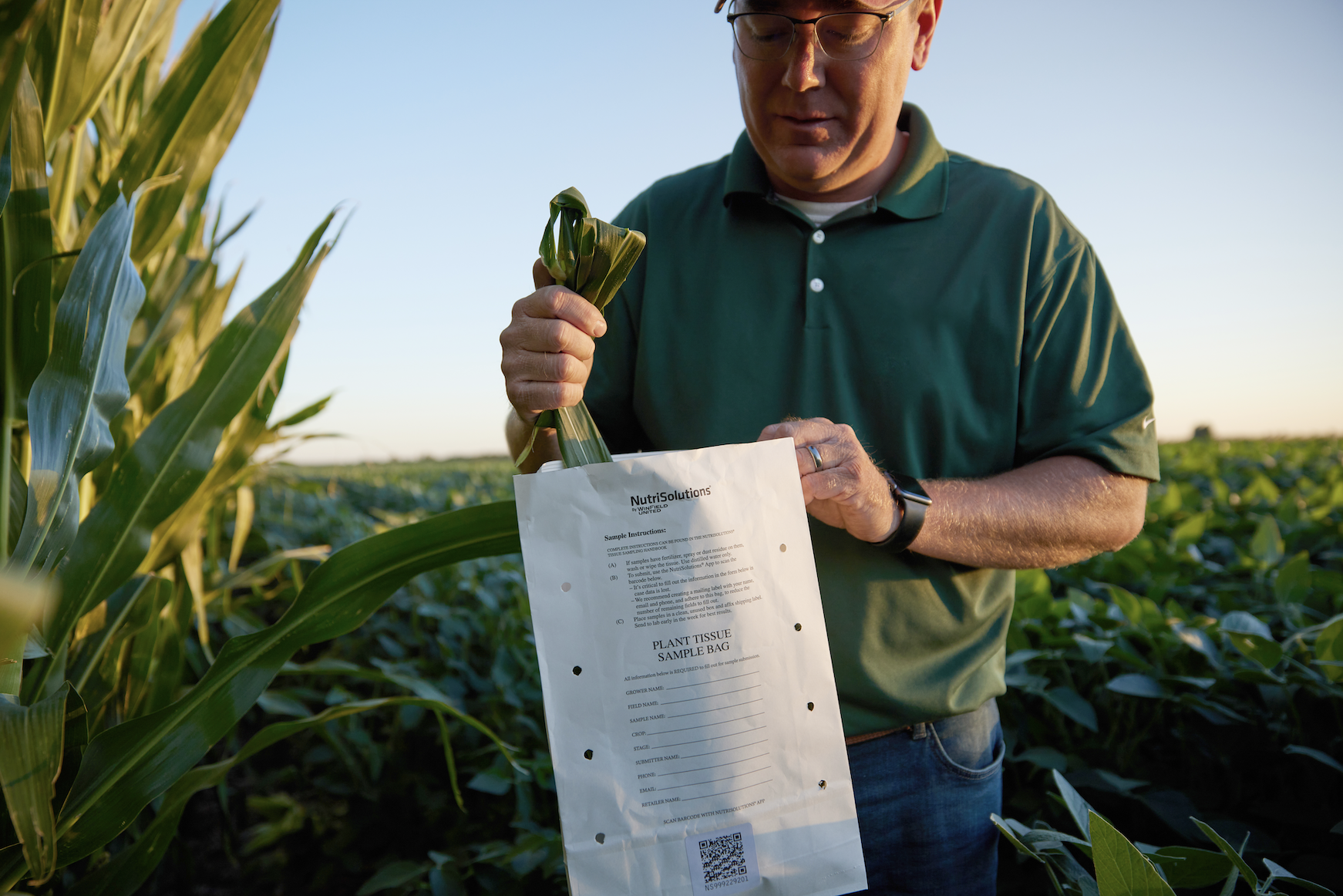Why You Should Plan to Use a Balanced Starter Fertilizer

To get crops off to a strong start, you need to provide adequate nutrition from day one. A growing body of research shows that using a starter fertilizer is the best way to do that, especially in the cooler soils common with reduced tillage.
Consider including a balanced starter fertilizer at planting, if you don’t already. Starters can help enhance these key factors for season-long impact.
OptiStart® balanced starter fertilizer includes the macronutrients of standard starters and has the added benefit of micronutrients in one formulation to help get plants out of the ground faster for optimal, more uniform establishment and robust plant vigor under all types of conditions. Applied in-furrow or 2x2, OptiStart fertilizer offers corn crops accessible nutrients for root and plant growth potential until they can source nutrients from the soil on their own.
Ascend2® plant growth regulator (PGR) is also a great addition to your starter mix. Its auxin-dominant, patent-protected formulation is backed by years of data and proven to promote vigorous emergence and root development. An in-furrow application of Ascend2 PGR is a simple, convenient way to enhance early-season crop growth and stress tolerance. Based on Answer Plot® trials, corn treated with Ascend2 had a 7.5 bushel per acre yield advantage compared to crops that only received a starter fertilizer.1
Root growth slows in cold soils, reducing the plant’s ability to absorb nutrients. Nutrient movement through the soil toward the root surface also slows when soils are cold. These effects are especially common in reduced tillage and high residue situations where moisture is held in the soil. A starter fertilizer can help overcome slow root growth in cool soils by putting critical nutrients in the root zone at planting.
The benefits of healthier, more extensive root growth can carry through the season to improve stalk strength and reduce lodging.
Balanced nutrition also helps increase a young plant’s ability to deal with stress from environmental and pest pressures. The stronger the seedling, the better the chance for a strong crop.
In addition to adequate early-season nutrition, planting conditions influence your crop’s season-long potential. Soils that are too cold, wet or dry at planting could delay germination and emergence. Our seed stress map monitors local soil conditions to help you make more informed management decisions. The map is updated throughout the season to help you understand what environmental stresses your crops could face.
Iowa State University Extension research indicates that starter fertilizers are more likely to result in a corn yield response under the following conditions:
For more information about starter fertilizers that may be a good fit for your operation, contact your WinField United retailer.
1 Compared to starter fertilizer alone. Based on over 60 trials across Answer Plot® locations in 15 states from 2017 to 2021.
2 Because of factors outside of Winfield United’s control, such as weather, product application and any other factors, results to be obtained, including but not limited to yields, financial performance, or profits, cannot be predicted or guaranteed by Winfield United. Results are based upon controlled tests and field trials. Actual results may vary.
All photos are either the property of WinField United or used with permission.
© 2023 WinField United. Important: Before use, always read and follow label instructions. Crop performance is dependent on several factors many of which are beyond the control of WinField United, including without limitation, soil type, pest pressures, agronomic practices and weather conditions. Growers are encouraged to consider data from multiple locations, over multiple years and to be mindful of how such agronomic conditions could impact results. Answer Plot, Ascend2, OptiStart and WinField are trademarks of WinField United. All other trademarks are the property of their respective owners.
Consider including a balanced starter fertilizer at planting, if you don’t already. Starters can help enhance these key factors for season-long impact.
Emergence
Faster, more uniform emergence is common with in-furrow starter fertilizer use because seeds have immediate access to essential macro and micronutrients. Faster germination and uniform emergence lead to a better crop stand, which is key to helping maximize yield potential.OptiStart® balanced starter fertilizer includes the macronutrients of standard starters and has the added benefit of micronutrients in one formulation to help get plants out of the ground faster for optimal, more uniform establishment and robust plant vigor under all types of conditions. Applied in-furrow or 2x2, OptiStart fertilizer offers corn crops accessible nutrients for root and plant growth potential until they can source nutrients from the soil on their own.
Ascend2® plant growth regulator (PGR) is also a great addition to your starter mix. Its auxin-dominant, patent-protected formulation is backed by years of data and proven to promote vigorous emergence and root development. An in-furrow application of Ascend2 PGR is a simple, convenient way to enhance early-season crop growth and stress tolerance. Based on Answer Plot® trials, corn treated with Ascend2 had a 7.5 bushel per acre yield advantage compared to crops that only received a starter fertilizer.1
Root Development
Better root development is more likely to occur with adequate early nutrition. Field observations have shown that corn planted with a balanced starter fertilizer such as OptiStart had visually bigger roots after just 15 days and noticeably more root mass after 4 weeks.2Root growth slows in cold soils, reducing the plant’s ability to absorb nutrients. Nutrient movement through the soil toward the root surface also slows when soils are cold. These effects are especially common in reduced tillage and high residue situations where moisture is held in the soil. A starter fertilizer can help overcome slow root growth in cool soils by putting critical nutrients in the root zone at planting.
The benefits of healthier, more extensive root growth can carry through the season to improve stalk strength and reduce lodging.
Plant Nutrition
Balanced nutrition is as essential for plants as it is for humans. Balanced starter fertilizers can help deliver sufficient amounts of key macro and micronutrients, making them immediately available to seedlings. Along with N, P and K, sulfur is needed for chlorophyll production and protein formation. The most common micronutrients in starter fertilizers are zinc for leaf growth and root development; manganese for chlorophyll production and nitrogen utilization; and boron for proper cell division, carbohydrate use and water utilization.Balanced nutrition also helps increase a young plant’s ability to deal with stress from environmental and pest pressures. The stronger the seedling, the better the chance for a strong crop.
Plant Stress Tolerance
Maximizing yield potential requires minimizing plant stress. But today’s high-population plant environments create additional stress for young plants. The early-season loss of just a few plants per 1,000 can add up to significant per-acre lost yield potential. Proper early nutrition is essential to enhance your crop’s early-season stress tolerance.In addition to adequate early-season nutrition, planting conditions influence your crop’s season-long potential. Soils that are too cold, wet or dry at planting could delay germination and emergence. Our seed stress map monitors local soil conditions to help you make more informed management decisions. The map is updated throughout the season to help you understand what environmental stresses your crops could face.
Iowa State University Extension research indicates that starter fertilizers are more likely to result in a corn yield response under the following conditions:
- Planting into cool soils
- Early planting.
- Planting into no-till soils with heavy residue.
- Planting in moderate to poorly drained soils.
- Late planting.
- Continuous corn planting, especially in no-till situations.
For more information about starter fertilizers that may be a good fit for your operation, contact your WinField United retailer.
1 Compared to starter fertilizer alone. Based on over 60 trials across Answer Plot® locations in 15 states from 2017 to 2021.
2 Because of factors outside of Winfield United’s control, such as weather, product application and any other factors, results to be obtained, including but not limited to yields, financial performance, or profits, cannot be predicted or guaranteed by Winfield United. Results are based upon controlled tests and field trials. Actual results may vary.
All photos are either the property of WinField United or used with permission.
© 2023 WinField United. Important: Before use, always read and follow label instructions. Crop performance is dependent on several factors many of which are beyond the control of WinField United, including without limitation, soil type, pest pressures, agronomic practices and weather conditions. Growers are encouraged to consider data from multiple locations, over multiple years and to be mindful of how such agronomic conditions could impact results. Answer Plot, Ascend2, OptiStart and WinField are trademarks of WinField United. All other trademarks are the property of their respective owners.


.jpg?ext=.jpg)

